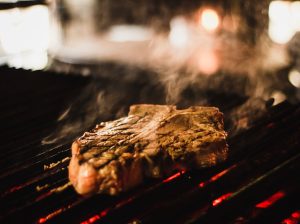The Strength of Black Steel
Black steel has a rich history that dates back to ancient times. The use of black steel can be traced back to the Iron Age, where it was used to create weapons, tools, and other essential items. The process of creating black steel was discovered by ancient civilizations through the use of iron ore and charcoal in a process known as smelting. This process involved heating the iron ore with charcoal in a furnace to create a high carbon content, resulting in the formation of black steel.
Throughout history, black steel has played a crucial role in the development of civilizations. It has been used in the construction of buildings, bridges, and other infrastructure, as well as in the creation of weapons and armor for military purposes. The durability and strength of black steel made it an essential material for various applications, and its use continued to evolve over time. In modern times, black steel continues to be a popular choice for construction and manufacturing due to its strength, versatility, and aesthetic appeal.
The history of black steel is a testament to its enduring significance and impact on human civilization. From its humble beginnings in ancient times to its widespread use in modern industry, black steel has proven to be an indispensable material with a rich and storied past.
Key Takeaways
- Black steel has a long history dating back to ancient civilizations, where it was used for weapons, tools, and construction.
- Black steel is known for its strength, durability, and resistance to corrosion, making it a popular choice for structural and industrial applications.
- Black steel is commonly used in construction, manufacturing, automotive, and infrastructure industries due to its high tensile strength and malleability.
- The advantages of black steel include its cost-effectiveness, recyclability, and ability to withstand high temperatures and pressure.
- The process of making black steel involves smelting iron ore with carbon to create a strong and versatile material for various applications.
- Maintenance and care of black steel involves regular cleaning, rust prevention, and protective coatings to prolong its lifespan and performance.
- The future of black steel in industry looks promising, with advancements in technology and manufacturing processes driving its continued use in various sectors.
Properties and Characteristics of Black Steel
Black steel is known for its unique properties and characteristics that make it a popular choice for a wide range of applications. One of the key features of black steel is its high carbon content, which gives it exceptional strength and durability. This makes it an ideal material for construction, manufacturing, and other industrial uses where strength and resilience are essential.
In addition to its strength, black steel also has excellent corrosion resistance, making it suitable for outdoor and marine applications. Its resistance to rust and corrosion makes it a reliable choice for structures and equipment that are exposed to harsh environmental conditions. Furthermore, black steel is highly malleable and can be easily shaped and formed into various shapes and sizes, making it a versatile material for different manufacturing processes.
Another important characteristic of black steel is its aesthetic appeal. The dark, matte finish of black steel gives it a sleek and modern look that is highly sought after in architectural and design applications. Its distinctive appearance adds a touch of elegance and sophistication to any structure or product, making it a popular choice for interior and exterior design elements.
Overall, the properties and characteristics of black steel make it a highly desirable material for a wide range of applications, from construction and manufacturing to design and aesthetics.
Applications and Uses of Black Steel
Black steel is widely used in various industries due to its versatility and durability. One of the primary applications of black steel is in the construction industry, where it is used to create structural components such as beams, columns, and reinforcement bars. Its high strength and corrosion resistance make it an ideal material for building structures that need to withstand heavy loads and harsh environmental conditions.
In addition to construction, black steel is also commonly used in the manufacturing of industrial equipment and machinery. Its malleability and strength make it suitable for creating components such as pipes, valves, and fittings that are essential for various industrial processes. Black steel is also used in the automotive industry for the production of vehicle frames, chassis, and other structural components that require high strength and durability.
Furthermore, black steel is a popular choice for architectural and design applications due to its aesthetic appeal. It is often used to create decorative elements such as railings, staircases, and furniture, adding a touch of elegance and sophistication to interior and exterior spaces. Its sleek, modern appearance makes it a sought-after material for contemporary design projects.
Overall, the applications and uses of black steel are diverse and widespread, making it an essential material in various industries ranging from construction and manufacturing to design and aesthetics.
Advantages of Black Steel
| Advantages of Black Steel |
|---|
| 1. High strength and durability |
| 2. Corrosion resistance |
| 3. Cost-effective |
| 4. Easy to fabricate and weld |
| 5. Recyclable and sustainable |
Black steel offers numerous advantages that make it a preferred choice for many applications. One of the key advantages of black steel is its exceptional strength and durability. Its high carbon content gives it superior tensile strength, making it suitable for heavy-duty applications where resilience is essential. This makes it an ideal material for construction, manufacturing, and industrial uses where structural integrity is paramount.
Another advantage of black steel is its corrosion resistance. Unlike other types of steel, black steel has a natural resistance to rust and corrosion, making it suitable for outdoor and marine applications where exposure to moisture and harsh environmental conditions is common. This makes it a reliable choice for structures and equipment that need to withstand the elements over time.
Furthermore, black steel is highly malleable and can be easily shaped and formed into various shapes and sizes. This makes it a versatile material for different manufacturing processes, allowing for the creation of complex components with precision and accuracy. Its malleability also makes it easier to work with during fabrication, reducing production time and costs.
In addition to its physical properties, black steel also offers aesthetic advantages. Its dark, matte finish gives it a modern and sophisticated look that adds a touch of elegance to any structure or product. This makes it a popular choice for architectural and design applications where visual appeal is important.
Overall, the advantages of black steel make it a highly desirable material for a wide range of applications, from construction and manufacturing to design and aesthetics.
The Process of Making Black Steel
The process of making black steel involves several steps that transform raw materials into the finished product. The first step in the process is the extraction of iron ore from the earth, which is then processed into iron using a blast furnace. The iron is then further refined through a process known as smelting, where it is heated with charcoal in a furnace to create a high carbon content.
The high carbon content gives the iron its characteristic dark color, resulting in the formation of black steel. The molten metal is then poured into molds or rolled into sheets, depending on the desired shape and size of the final product. The finished black steel is then cooled and treated to improve its mechanical properties before being used in various applications.
The process of making black steel requires precision and expertise to ensure the quality and integrity of the final product. From the extraction of raw materials to the final fabrication of components, each step in the process plays a crucial role in producing high-quality black steel that meets industry standards.
Maintenance and Care of Black Steel

Proper maintenance and care are essential for ensuring the longevity and performance of black steel products. One important aspect of maintaining black steel is protecting it from corrosion. While black steel has natural corrosion resistance, exposure to moisture and harsh environmental conditions can still lead to rust formation over time. Regular cleaning and application of protective coatings can help prevent corrosion and extend the lifespan of black steel products.
In addition to corrosion protection, regular inspection and maintenance are important for identifying any signs of wear or damage that may affect the structural integrity of black steel components. This includes checking for cracks, dents, or other forms of damage that could compromise the strength and safety of the product. Prompt repairs or replacements should be carried out as needed to ensure continued performance.
Furthermore, proper handling and storage are important for preserving the quality of black steel products. This includes avoiding exposure to extreme temperatures, moisture, or corrosive substances that could degrade the material over time. Storing black steel components in a dry, well-ventilated area can help prevent damage and deterioration.
Overall, proper maintenance and care are essential for maximizing the lifespan and performance of black steel products. By following best practices for maintenance and handling, users can ensure that their black steel components remain in optimal condition for years to come.
The Future of Black Steel in Industry
The future of black steel in industry looks promising as demand for strong, durable materials continues to grow across various sectors. With ongoing advancements in manufacturing technology and processes, black steel is expected to play an increasingly important role in meeting the needs of modern construction, manufacturing, and design projects.
In addition to its traditional applications in construction and manufacturing, black steel is also gaining traction in emerging industries such as renewable energy and sustainable infrastructure. Its strength, durability, and corrosion resistance make it an ideal material for supporting renewable energy projects such as wind turbines and solar panel structures. Furthermore, its aesthetic appeal makes it a popular choice for sustainable architecture and design projects that prioritize both functionality and visual appeal.
As industries continue to seek innovative solutions for their material needs, black steel is likely to remain a top choice due to its unique combination of properties and characteristics. With ongoing research and development efforts focused on enhancing the performance and sustainability of materials, black steel is poised to remain a key player in shaping the future of industry.
In conclusion, black steel has a rich history dating back to ancient times when it was used for weapons, tools, construction materials, etc., during the Iron Age. It has unique properties such as high carbon content which gives it exceptional strength & durability; excellent corrosion resistance; malleability; & aesthetic appeal which make it suitable for various applications such as construction (beams & columns), manufacturing (pipes & valves), automotive (vehicle frames), architectural & design (railings & furniture). Its advantages include exceptional strength & durability; corrosion resistance; malleability; & aesthetic appeal which make it highly desirable across various industries. The process involves extraction & processing of iron ore into iron using blast furnace; further refining through smelting with charcoal; pouring into molds or rolling into sheets; cooling & treatment before use in various applications. Proper maintenance & care are essential for ensuring longevity & performance by protecting from corrosion; regular inspection & maintenance; proper handling & storage. The future looks promising with increasing demand across sectors including renewable energy & sustainable infrastructure due to ongoing advancements in manufacturing technology & processes which will continue shaping the future of industry with ongoing research & development efforts focused on enhancing performance & sustainability.
If you’re interested in black steel, you might also want to check out this article on the benefits of using black steel in construction and design. Click here to read more about how black steel can add a sleek and modern look to any project.
FAQs
What is black steel?
Black steel is a type of steel that has a dark, matte finish due to the iron oxide scale formed on its surface during the manufacturing process. It is commonly used in construction, manufacturing, and industrial applications.
How is black steel different from other types of steel?
Black steel is different from other types of steel, such as stainless steel or galvanized steel, primarily due to its surface finish. It has a rough, non-glossy appearance and is not coated with any protective layer, making it more susceptible to rust and corrosion.
What are the common applications of black steel?
Black steel is commonly used in the construction of buildings, bridges, and infrastructure. It is also used in the manufacturing of automotive parts, industrial equipment, and furniture. Additionally, black steel pipes and tubes are widely used in plumbing and gas distribution systems.
How is black steel made?
Black steel is made through a process called hot rolling, where the steel is heated to high temperatures and then passed through rollers to shape it into the desired form. During this process, the iron oxide scale forms on the surface, giving it the characteristic black color.
What are the advantages and disadvantages of black steel?
Advantages of black steel include its strength, durability, and cost-effectiveness. However, it is more prone to rust and corrosion compared to other types of steel, and it requires proper maintenance and protection to prevent deterioration.














Post Comment
You must be logged in to post a comment.